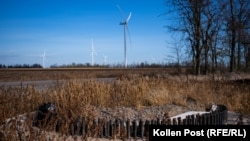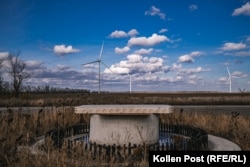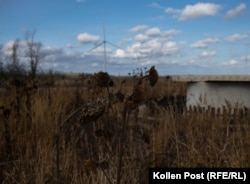KOBLEVE, Ukraine -- The black earth of southern Ukraine is some of the most fertile soil in in the world, a source of grain taken for granted across the globe before Russia sought to shut down exports last year as part of its assault on the neighboring country.
Today, tucked away in that agrarian heartland, Ukrainians are harvesting a new crop: electricity.
In the middle of sunflower and wheat fields about 15 kilometers north of the Black Sea, Maksym Bohadytsya waited for the Ukrainian military to call off an air alert one afternoon last month. It wouldn't happen until the Russian MiG-31 that set it off landed back at its base nearly 1,000 miles to the northeast.
It was the third of four alerts that will sound out across the Mykolayiv region that day, this one beginning at noon and lasting three hours. Though Bohadytsya was hardly fearful out in the fields, it did keep him away from the substation and the transformer at the heart of the wind farm that he manages -- a target for Russian attacks on vital infrastructure as winter falls.
Russia launched numerous missile and drone attacks on Ukrainian energy facilities and other civilian infrastructure in 2022, assaults that European Commission President Ursula von der Leyen called "acts of pure terror."
Now Ukrainians face their second winter since Russia's full-scale invasion in February 2022.
"Intensifying Russian attacks on the country's energy facilities, amid heavy snow and freezing temperatures, are worsening the dire humanitarian conditions across the country," UN Assistant Secretary-General Miroslav Jenca said on December 6.
Though a massive white obelisk, the wind turbine Bohadytsya waited under, and its brethren that poke out over rows of acacia trees have proved remarkably tough targets. Russian attacks have yet to take any offline.
"We are very ready for the winter," Bohadytsya said.
"First of all, construction is finished. We can give full power to the station," he said, referring to the plant's first phase, which includes 19 turbines.
Set up mostly since the start of Russia's full-scale invasion, amid continuous threats from above, the Tylihulska Wind Power Plant is only partially completed, but at 114 megawatts (MW), it is the largest of its kind in government-held territory in Ukraine.
'Russia's Swamp'
In a way it's symbolic. Ukrainian history textbooks point to the local agricultural abundance as a catalyst for a governing system and an identity distinct from Muscovy -- where harsh winter conditions, the argument goes, led to a centralization of power. Meanwhile, the southern farmers were more self-sufficient and maintained that sense of egalitarianism and liberty to, they say, the present day.
"Everything's better here than in Russia. The people are better. The sky's bluer. The water -- so much better," Bohadytsya said. "But Russia is always trying to pull us into their swamp."
The wind farm would have fallen into Russian hands if Moscow's forces taken the city of Mykolayiv and moved on to Odesa, further west on the Black Sea coast, as had been their fervent hope.
Bohadytsya grew up in a small town outside Mariupol, on the Sea of Azov in the Donbas to the east, ultimately following in the footsteps of his father, an electrical engineer. He spent 15 years at power plants in the area, which depend on fossil fuels; in fact, the Donbas takes its name from the massive coal basin underlying it.
Maybe as a result, Bohadytsya looks more himself wearing a hard hat than not, puffing menthol smoke into a brisk wind that the widgets in the base of the nearest tower clocked at 11.5 meters per second. A perfect day for power.
When Russia fomented war in the Donbas in 2014, Bohadytsya took his family and left home, ultimately finding himself working for DTEK, the energy company that built and operates Tylihulska, first at a solar plant across the Dnieper River from the Zaporizhzhya nuclear power station, which was seized by Russian forces early in the full-scale invasion. By then he was already gone, rebased to Mykolayiv to set up what was projected to be the largest wind power plant in the country.
His hometown and his parents are now living under Russian rule.
Crop Rotation
DTEK is hardly alone. Wind turbines now breach the horizon from Moldova to the Dnieper and beyond, gathering gusts off the Black Sea. The arrangements are much the same as at DTEK Renewables, the wind- and solar-focused subsidiary of the larger energy giant: It pays local farmers for the use of their land, laying down grids of underground cables and aboveground dirt roads linking the individual turbines but, the company says, disrupting agriculture as little as possible.
There is a catch: Such wind plants require massive initial expenditures. Owned by Ukraine's richest man, steel and coal tycoon and controversial political funder Rinat Akhmetov, DTEK is the largest private energy producer in the country. It had planned out the Tylihulska plant to have a maximum capacity of 500 MW, which would make it by far the largest wind farm in Ukraine and the fourth largest in Europe. By comparison, the capacity of the Kakhovka dam, which was destroyed in June while under Russian control, was 357 MW.
At the moment, only 19 of the planned 83 turbines are up, and 64 bare concrete outcroppings remain, dotting these fields, with bolts jutting upward in rings awaiting more installations. Electric cables connect them underneath the fields but lie, as it were, fallow.
The wind farm's foreign backers froze their investment at the outset of the full-scale war. The Danish company Vestas produces the massive 6 MW turbines, whose blades crest at just under 200 meters into the sky. Vestas pulled all of its servicers out of Ukraine shortly after the 2022 invasion and has yet to allow them back in. The Danish, German, and Polish crews who had been setting up the plant were pulled out of the country. Vestas also called the fleet it uses to ship these massive turbines out of the Black Sea for good.
At the time, only four of the turbines were functional, with two more up and waiting to go live. There were no provisions for further development of the project.
When reached for comment, Vestas representative Claes Lautrup Cunliffe wrote to RFE/RL, "Unfortunately, this isn't something we can prioritize at the moment."
Construction of the wind farm might have remained in limbo, but DTEK's maintenance workers did what Ukraine has been forced to do for much of the past two years: They figured it out themselves.
They managed to put up the remaining turbines using local crane operators and Ukrainians who worked out the assembly. Working around the clock last winter, Bohadytsya recounted, they matched what he said was the world record for installation of one tower in just six days, as the national grid operator was losing power under air strikes and desperately trying to make up for the deficit.
At one point, an installation crane frosted over, and most of the workers said it would have to wait until the weather warmed up again. Instead, a local drone-maker for the Ukrainian military set them up with a six-rotor drone with a tank of defrosting fluid that they flew up through winter fog to get the crane back to work.
The Horizon
DTEK has been behind several of the largest renewable projects in the country, including the Pokrovsk and Nikopol solar plants, the latter of which was Bohadytsya's workplace before the new wind farm.
The company was also behind the largest wind projects in the country prior to Tyhulska. To get the farmers of the area on board with the project, DTEK took them on tours of the 200 MW Botiyeve wind power plant in the Zaporizhzhya region. The Botiyeve, Prymorsk, and Orlivka plants line the coast between Melitopol and Mariupol -- now Russian-occupied territory.
So far it has proved impossible to get wind turbines of this size into place any way other than by ship. Vestas maintains a private fleet for just this purpose, but the Black Sea is embroiled in the war.
Despite this barrier, on December 4, DTEK and Vestas released a memorandum of understanding that says the Danish company "will supply wind turbines to Ukraine for the construction of the second stage of the [Tylihulska] windfarm."
DTEK "is ready to start construction of stage two in Q2 2024 and expects to complete it by the end of 2025," the memorandum of understanding reads.
To get around Russia's efforts at a Black Sea blockade, the companies are planning on using a new overland route to deliver the additional 64 turbines to Ukraine, said Ben Harding, a DTEK representative. Once the turbines are at the site, entirely Ukrainian crews will set them up on the vacant patches. The route had been untenable due to the massive span of the turbines, but the firms say they've figured out a way to ship them in.
Financing of the project's estimated cost of 450 million euro remains tentative, however, with DTEK citing unnamed commercial banks with state guarantees. "The project for the next couple of months will be securing the financing," said DTEK's Ben Harding.
An extensive map of the Tylihulska site, which from above resembles the constellation Orion, hangs in anticipation on the wall of the central substation. The company did not allow photography at the transformer, citing security concerns.
A 3D rendering of the map greeted visitors at a recent conference in Warsaw focused on reconstruction in Ukraine. "Investing in Ukrainian renewable energy is investing in European energy security," said a pamphlet DTEK was distributing to attendees, citing "our resistance on the energy front."
DTEK is sketching out a potential wind farm further north, near Poltava. The destruction of the Kakhovka Dam has left the Dnieper impassable to ships big enough to haul Vestas's 6 MW turbines. A potential overland route has major implications for such a project and for the broader interests of a country forced to reconfigure its electrical grid on the fly.
Despite a major drop in Ukraine's total generation, it has managed to endure winter electricity demands surprisingly well. "I am convinced that we will be able to repeat this victory this year," Denys Shmyhal said in a statement on December 12, celebrating two recent days of peak heating demand without blackouts even as Russia fired fleets a number of ballistic missiles that Ukrainian forces shot down near Kyiv.
But, as winter falls, Harding voiced confidence in the reliability of the facilities already in place, saying that Russian air attacks have yet to damage any of their wind turbines.
"At 300 MW you'd need 50 missiles," he said.















